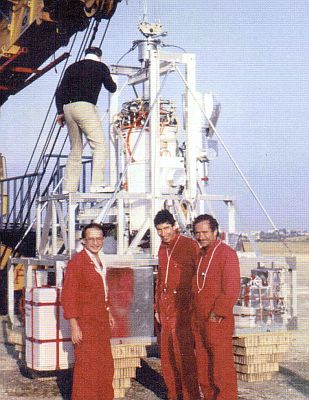Purpose of the flight and payload description
TIFANI (Telescope Infrarouge Froid pour l'Astronomie des Nuages Interstellaires) was an experiment resulting from the collaboration between four french laboratories: the Laboratoire d'Astronomie Infrarouge, Observatoire de Paris, Meudon, the Centre d'Etudes Spatiales des Rayonnements, in Toulouse, the Section d'Astrophysique du C.E.N. in Saclay and the Institut d'Astrophysique, in Paris. The scientific objective of the instrument was to perform spectrophotometry of the far IR dust thermal emission, and detection of fine structure lines in HII regions.
TIFANI was composed by a f/6 Cassegrain type telescope, featuring a 25 cm diameter primary and a fixed hyberbolic secondary giving 6.5% of obscuration. The mirrors and the structure were made from aluminium alloy, which allowed an efficient cooling and a good homogeneity in temperature. Cold baffles prevented direct radiations to reach the optics for angles above 16°.
At the focus of the telescope was located a Michelson interferometer used in a fast-scanning mode which allowed no sky-chopping. The two mirrors were spherical, so that the cold aperture stop was at the centre of curvature of each one. Frictions were avoided thanks to the use of flexural pivots, a linear electromagnetic motor and of inductive position sensors. The whole system (motion and sampling) was controlled by a micro-processor.
The detection system was composed by two separate field of view of 10 arc min diameter each, and separated by 15 arc min. which were feeded by the interferometer: one corresponded to a bolometric channel (Coron-type bolometer) with a cut-on at 50 micron and the other to a dual photoconductor channel where two spectral bands were separated by means of a CsBr dichroic crystal. The photoconductor channels had band-pass defined by Restrahlen filters (KCl and KI) which were centered on 58 microns and 88 microns respectively. The preamplifiers were of trans-impedance type for the photoconductors and classical low-noise type for the bolometer.
Two separate cryostats were used to cool the optics on one side and the detection system on the other side. The first one was an annular container of solid nitrogen, containing a heat exchanger allowing extra-cooling by the helium vapors. Thermal isolation was provided by aluminized mylar. The second cryostat consisted of two coaxial containers of liquid helium, the external one being used for cooling of nitrogen and optics by a flow of cold gas. A polyethylene sheet at top of the secondary mirror prevented condensation of the atmospheric water vapor. A leak-proof door at top of the cryostat was opened at maximum altitude only. Holding time was 36 hours for 35 + 10 liters of liquid helium and 45 liters of liquid nitrogen.
Details of the balloon flight
Balloon launched on: 7/10/1984
Launch site: Base di Lancio Luigi Broglio, Trapani, Sicily, Italy
Balloon launched by: Agenzia Spaziale Italiana (ASI) / Centre National d'Etudes Spatiales (CNES)
Balloon manufacturer/size/composition: Zero Pressure Balloon 330.000 m3
End of flight (L for landing time, W for last contact, otherwise termination time): 7/10/1982
Landing site: Lost in the Mediterranean sea, 250 km from Spain's coast
Campaign: ODISSEA 84
Payload weight: 1200 kgs
The balloon was launched flawlessly from the Trapani-Milo base in Sicily on Juli 4, 1984. After starting a nominal westward path towards Spain (as usual for transmediterranean flights) apparently the balloon developed a problem and as a result the payload sunk in the Mediterranean Sea, 250 km from Spanish coast.
External references
- A balloon-borne cooled telescope for far IR astronomy Proceedings (A83-40419 18-89). Garching, European Southern Observatory, 1982, p. 355
- Fourier interferometers in the far-infrared and sub-millimeter ranges. Comparative study of their performances for spaceborne applications Journal of Optics, 23(5), 179
- Research on Far Infrared Photoconductors ESO Infrared Workshop Proceedings of the 2nd ESO Infrared Workshop, held in Garching, April 20-23, 1982, Garching
2052If you consider this website interesting or useful, you can help me to keep it up and running with a small donation to cover the operational costs. Just the equivalent of the price of a cup of coffee helps a lot.


